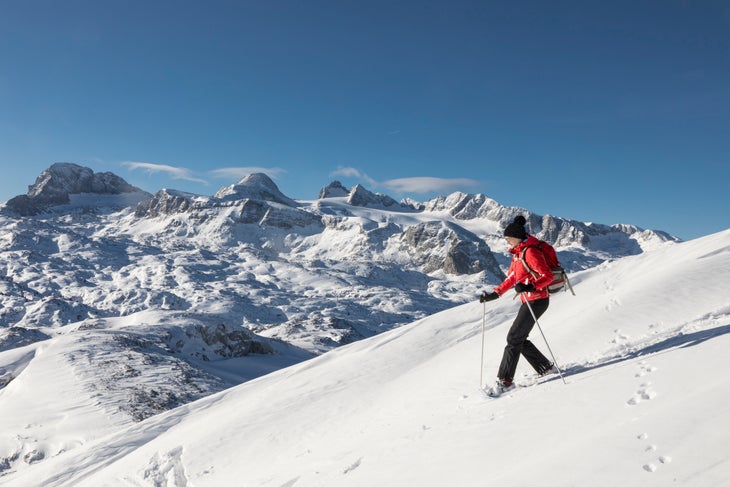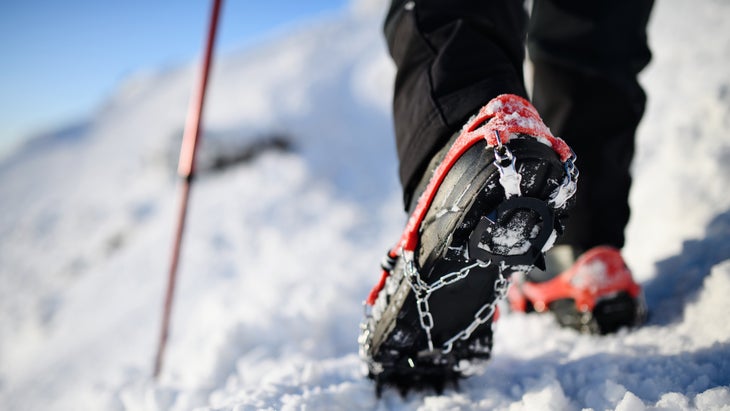Heading out the door? Read this article on the new Outside+ app available now on iOS devices for members! Download the app.
The onset of winter doesn’t have to put a stop to your outdoor adventures—even if you’re not a skier. Comfort walking on snow will unlock a new world of hiking potential year-round, from wintery forest rambles to mountaineering objectives to crossing spring and snowfields on high peaks. Successful snow travel hinges on your ability to understand the terrain and move efficiently across it. Learn how to do so safely with these strategies from Colorado Mountain School guide Ian Fowler.
Going Up
Before ascending a snow-covered slope, assess the risk factors. Is an avalanche possible? Has sun turned the snow into slush, or is it frozen solid with an icy crust? Travel is easiest on firm, but not rock-hard, snow. In winter, wait for the sun to soften icy spots. In spring, start early before slopes turn to slush. “Nothing drains efficiency like soft, punchy snow,” Fowler says. If you’re confident that it’s safe to continue climbing, choose from the following techniques based on the incline and snow quality.
The Duck Walk
On low-angle to moderate slopes that feel slippery to walk up normally, splay your feet outward so that your heels are closer together than your toes. This maximize surface contact between your boot soles and the snow. Take wide steps and kick into the slope with the inside edge of your foot for better purchase.
The American Step
When the slope gets too steep for flat-footed travel to feel secure, use this technique to keep going straight up: Face uphill, splay one foot outward (like the duck walk) and kick in with the other toe. Alternate sides when one leg tires.
Kick Steps
For booting up short steeps in soft snow, kick twice, perpendicular to the slope, to create a platform for your foot. Straighten your rear leg after each step to lengthen contracted muscles and “rest” your weight on your bones.
The French Technique
On steep, hard snow when you are wearing crampons (see below), save energy—and your calf muscles—with the French step. Make long switchbacks and use a crossover step to avoid wearing out your uphill leg. Point both feet slightly downhill to ensure maximum surface contact between your crampon spikes and the snow. Bring your back foot around, planting it uphill and in front of your leading foot. Use an ice axe for balance.
Going Down

Downward momentum gives falls more consequence, so always stay alert when descending. Before you head down, check for loose straps, clothing, and laces that could cause you to trip. Before heading out, brush up on self-arrest techniques so you can stop yourself in the event of a fall.
Plunge Step
For direct descents in soft snow, face away from the slope. Ram your heel into the snow and point your toes to the sky to keep from slipping.
Stomping
In firm snow, splay your feet duck walk-style and stomp. “Keep a flex in your knees and your nose over your toes,” Fowler says. Switchback on steeps, and face the slope if you feel insecure.
Get a Grip
While your regular hiking shoes or mountaineering might be grippy enough for short snowfield crossings or moderate climbs, hard snow, icy patches, and steep slopes might require additional traction. There are many options out there; here’s how to choose the best for you.
Chains
Ice cleats or devices like Yaktrax are best for snowy trails or flats, especially when running or moving quickly. Chain-style traction typically lacks the bite required for icy hills, so get something more substantial for true alpine missions.
Microspikes

These work well for hikers exploring icy terrain or gentle slopes with safe fall zones. They can provide a false sense of security and aren’t meant for steep, firm terrain, so be especially cautious when wearing them.
Crampons
For hard snow, steep slopes, and no-fall zones, you need high-level traction. Wear them with mountaineering boots and use an ice axe for additional protection and balance.
